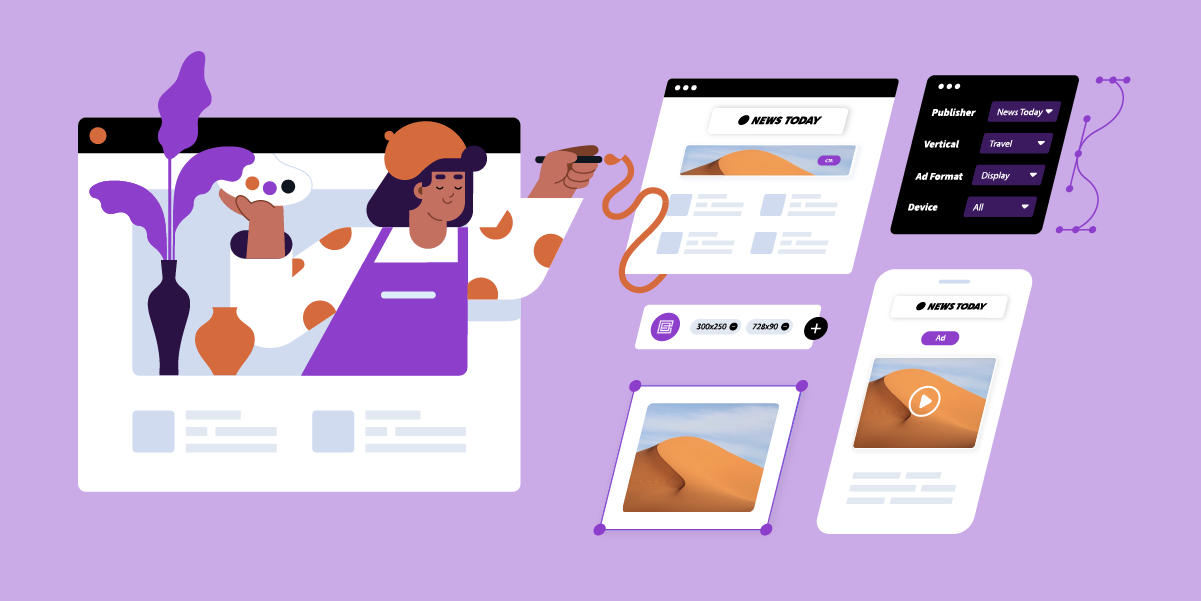Taking the necessary time and effort to plan your programmatic campaign can help secure the utmost success in execution. It can also ensure you are prepared to pivot even before you hit that launch button! To prepare your campaign plan, you’ll set your key performance indicators (KPIs), determine a budget, and leverage your customer profiles and buyer personas to settle on the desired audiences you need to launch your campaign.
With these campaign details in hand, it’s time to get started on campaign planning. The right demand-side platform (DSP) will provide you the features and support needed to run your campaign successfully, and meet your campaign goals.
Use Forecasting to Plan Your Campaign
The right DSP will have campaign forecasting, a feature that you can leverage to understand how well your campaign will potentially scale before it’s launched, and to figure out the most effective way to spend your budget. It gives you the ability to identify the highest-value opportunities, and ultimately, reach customers across an optimal media mix.
Forecasting can help you find answers to two important pre-campaign questions:
- Can I identify the highest value audience for my target demographic?
- And; Will I be able to spend my budget in full and scale sufficiently?
Since it’s designed to help you understand how well your campaign would perform before it’s launched, it’s best to use this DSP feature in the early planning stages of your campaigns. If you know what your budget is, and have an idea of what locations and audiences you’d like to target, then you’re in the perfect position to use this planning functionality.
By predicting your campaign results ahead of time, you can make sure you’re selecting the parameters that will help you reach the right audience, and maximize the impact of your ad dollars. You may also discover opportunities for ad spend that you may have not even realized were there for you.
Decide on Campaign Channels and Tactics
Deciding on campaign channels and tactics is a key part of campaign planning, especially if you have budget limitations. You want to evaluate what channels will maximize the impact of your media dollars. If your budget is less restrictive, then it can be beneficial to get creative and test various channels within your media plan to determine which combination of channels is best received by your audience.
Make sure your DSP offers the channels that are best suited to your campaign goals. A full-funnel strategy will help you achieve those goals, and each level of the funnel can be captured through a mix of channels like connected TV (CTV), video, native, display, and audio.
- CTV and video are ideal for telling brand stories, and for mass communicating about a promotion, event, or featured product.
- Native is best for engagement, sharing information, and education. Leverage blogs to inform customers about different product highlights and reviews.
- Display is a reliable and dynamic format that you can use to lift the performance of the other channels. Display provides both performance and scale and is generally the most cost-effective channel. It is best used with a call to action such as “shop now”, or “book a test drive.”
- Audio is immersive, engaging, and reaches people in screen-free, undistracted moments. Audio ads are effective for building brand awareness, paired with positive brand association.
You can also opt to use a mix of complementary channels with a multi-channel campaign strategy. You can reach consumers throughout the entire funnel, creating a cohesive story across audio, native, display, video and CTV. Utilizing multiple channels increases the percentage of the total target audience you’re able to reach, and helps present a cohesive brand story throughout the customer journey.
Align Creative Assets and Messaging
The final step to planning an effective programmatic campaign is to plan your creative and messaging. Both should resonate with your target audience to ensure you attract the users who are most likely to engage with your campaign. The creative and messaging of the landing page that your ad drives traffic to should also be aligned to maximize overall engagement.
It’s important to ensure that your ad is engaging from the start. If you don’t capture the attention of your audience immediately, then you risk them moving on. To avoid this, hook your target demographic in the first few seconds by using language or imagery that speaks to them, intrigues them, or spurs an emotional response.
Use creative features like dynamic geo to personalize the ad to your target audience based on location. And, you can leverage an interactive feature like scratch to reveal, or in-banner video to engage the viewer right away. Finally, include your brand logo and call-to-action (CTA) from the onset of a video or HTML5 ad. This will help your audience remember your brand and know what to do once they click through.
Get Started With Programmatic Campaign Planning
Forecasting, deciding on campaign channels and tactics, and aligning creative assets and messaging are three key steps to begin with when planning your programmatic campaign. From there, you’ll want to identify the most important KPIs for your campaign, so that after launching you can evaluate your campaign’s performance and make the right optimizations. And to help with your campaign planning, be sure to refer to our programmatic campaign checklist!
Want to plan exceptional programmatic campaigns? Request a demo to learn more about StackAdapt.





